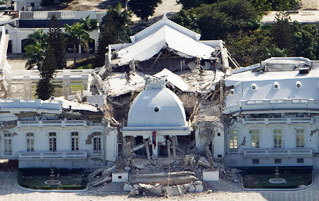4 Things You Can Only Learn by Surviving an Earthquake

In January 2010, John and his younger brother were two of thousands of foreigners in Haiti. John was in the middle of chatting online with a girl he liked back home, pondering that age-old question -- what exact combination of emojis makes a woman love you? -- when suddenly the building began to buck and shake. A 7.0-magnitude earthquake had just struck the country, the strongest in over 200 years. John never learned the emoji love cheat code (it's cross-eyed face, four-leaf clover, heart with wings, for the record), but while living through the ensuing catastrophe, he did learn a few other things.
Prepare All You Want, Sometimes Survival Is Just a Matter of Luck

To hear John tell it, a bubble of invincibility surrounded the brothers while the world around them crumbled: Either one of them is secretly Sue Storm, or they both got incredibly lucky. Their living quarters were located in a small two-story annex of a sprawling hotel. The annex stayed upright despite the powerful quake, while the main hotel building -- all five stories and 145 rooms of it -- crumbled to the ground, killing 80 people. We're laying odds on "incredibly, incredibly lucky."

Fuck it. Add another "incredibly" to that.
John freaked out as soon as the shaking began, which is a normal reaction when the ground beneath your feet tries to murder you. He ran from room to room like a chicken with its head cut off ... that was also caught in the middle of an earthquake in Haiti. Luckily, before John had a chance to run out the front door, his brother ordered him to stay put underneath the door frame.

The door frame the brothers crouched under. The annex can be seen immediately to the left of the door frame, still standing.
On the right, the edge of the main building, crushed.
John watched as an avalanche of debris slid right past them. The hotel and its annex were perched on the mountainside, and tons of concrete were sent roaring down the slope. Had John run out the door, he'd have been surfing a wave of rubble all the way to Valhalla, which only sounds awesome in theory. To this day, John agonizes over alternate scenarios. "What if my brother and I had gone out, like we intended to?" he asks. "What would have happened to us then?" Considering the death toll of the Haitian earthquake, those are some pretty easily answered hypothetical questions.
Surviving the Big Earthquake Is Just the Start of the Danger

John and his brother had survived the initial quake, but they still had to climb down from the unstable annex before it collapsed under its own weight. The buildings around them had been sheared away like God gave the Earth a buzz cut, leaving a fairly direct (if utterly terrifying) path down to the street below. The dirt left behind was extremely soft, like it had been churned. John sank to his ankles with every step. This kind of powdery soil is not uncommon after an earthquake. It's known as liquefaction, and it involves the top layer of earth blending with the groundwater during a strong tremor. The muddy concoction that results can feel like quicksand.

It is the diarrhea of Tor, the epileptic earth god.
An aftershock could have come at any moment, sending a two-story building right over like the worst possible game of Red Rover.
When they hit the street, the dust storm kicked up by all that debris led to confusion. "We couldn't see anything for like the first four minutes," John says. "We couldn't see the horizon, to see what was happening. I'd look up, and I couldn't see the sky." Eventually the brothers managed to make out two more people nearby: a housekeeper from the hotel and a photojournalist from Belgium (the one who took all the pictures). "When the dust cleared out," John recalls, "the whole city started to scream. And I mean everyone."

Tragedy breeds unity.
"What?" John asked.
Presumably accompanied by ominous, swelling music, his brother told him to hold his palm against the ground. That's when John realized that the Earth was vibrating beneath them. From that moment until the day he left the country, he felt that constant buzz every time he stood still. That's because, when it comes to a 7.0-magnitude earthquake like the one in Haiti, the aftershocks can last for upward of a decade. Naturally, the tremors become less perceptible with each passing year, but for those first few days, they are frequent and seemingly endless, every 15 to 20 minutes. It's like the planet itself doesn't want you to forget that it is stone-cold crazy and will jack you up for so much as littering.

"I see you, motherfucker."
That's when John and his brother first realized that the big quake was just the start. There were the obvious dangers (crumbling structures, aftershocks), and the less obvious: Fires were breaking out en masse because of the compromised electrical grid. The most tragic fallout began nine months later, when a cholera outbreak swept the country. By 2013, it had claimed over 7,800 lives. So what caused it? Damaged sanitation lines? Lack of medical supplies? Pestilence, the Horseman of the Apocalypse, just getting a few cheap shots in while the country was already down? Nope: It was a group of U.N. peacekeepers who accidentally brought the disease from abroad when they arrived in Haiti to aid in the recovery. A plague of irony ravaged the population not long afterward.
Your Coping Strategies May Get a Bit ... Weird

That first night, John and his brother slept in the car of a fellow survivor. The next morning, they had to decide whether to stay up in the mountains and wait for the rescue effort or cross the rubble to get closer to it. They chose to keep moving. The first step was to cross the Israeli consulate, or what was left of it, located just beneath their makeshift sleeping quarters.

Having to make do through chaos and destruction seemed pretty routine to the Israelis.
The Israeli consulate had been a beautiful and ornate building, but more than half had collapsed. All that was left was a massive, dangerous, uneven pile of debris that the brothers would have to find their way through.
Hey, gamers: Does that setup sound familiar? It's like one ethnic stereotype and a swinging blade away from a Prince of Persia level.

John didn't say anything about retrieving mysterious relics, but we just kind of assumed.
The realization was not lost on John, and here is where it gets weird for him: He actually remembers the whole experience as though he was playing a video game level. The series of decisions he had to make on the spot were translated into gaming language. The gaping holes he needed to jump over, the unstable rubble he had to maneuver through ... these became obstacles to clear. Archways turned into checkpoints. The ground looked like it could collapse at any second, but John felt only the adrenaline of crossing it, not fear -- even though it had been at least a few decades since his last save point.
"This was the strangest moment for me," John says. "I don't know if what I had was the most appropriate reaction, you know?"

Curse him for not conforming to our expectations of victimhood!
John's "virtual" experience is actually pretty common: It's an example of depersonalization (when a person feels like they're watching themselves) and derealization (when a person's surroundings suddenly seem unreal). Long before we invented video games, our brains knew that some traumas were just too horrifying for the puny cotton strands of our sanity. It's not uncommon for people to recall traumatic moments as if it was all a movie, and they were the protagonist.
Funny how nobody casts themselves as the red-shirted extra.
Survival Is Surreal

It would take a few more days for John and his brother to be evacuated from Haiti. When he got home, there was a message on his Facebook wall from the girl he liked -- the one he'd been flirting with seconds before the earthquake hit. "Are you OK?" it read. Obviously, according to movie rules, John dated the hell outta that girl in his first few weeks back. But this is reality, and John suspects she only said yes because she felt like she couldn't say no in good conscience. Surviving a Haitian earthquake is one thing; surviving heartbreak is a harrowing tale for another article.

Both require copious amounts of whiskey to get through.
When you make it through a catastrophe that decimates an entire country, killing hundreds of thousands of its citizens, it can be hard to process. Harder still when you come home to a lot of possibly unwelcome media coverage. John wants to stay anonymous, so we can't point you to the stories, but there was a lot of attention, and he didn't feel he could shut himself off from the overwhelming goodwill given by his community just because he was still a bit rattled by the time the Earth tried to swallow him whole. Experts have a term for this early stage in post-trauma: It's called the honeymoon phase. It seems like some pretty cynical phrasing on the part of psychiatrists to infer that marriage is some sort of soul-scarring disaster.

"No, no! The wedding is the disaster in this analogy. The marriage is years of depression and horror afterward!"
Positive attention or not, John couldn't exactly rejoice in the miracle of his own survival. He knew people who had died in the earthquake. He also knew that his survival over theirs came down to nothing more than the most haphazard luck, the help of strangers, and possibly some latent force-bubble powers.
Related Reading: We're all about talking to people with interesting lives, like this Homeland Security agent who went undercover with the cartels. We also talked to a woman who spent her childhood as the accomplice to a mass murder and this big bunch of drug dealers. Have a story to share with Cracked? We're right here.
